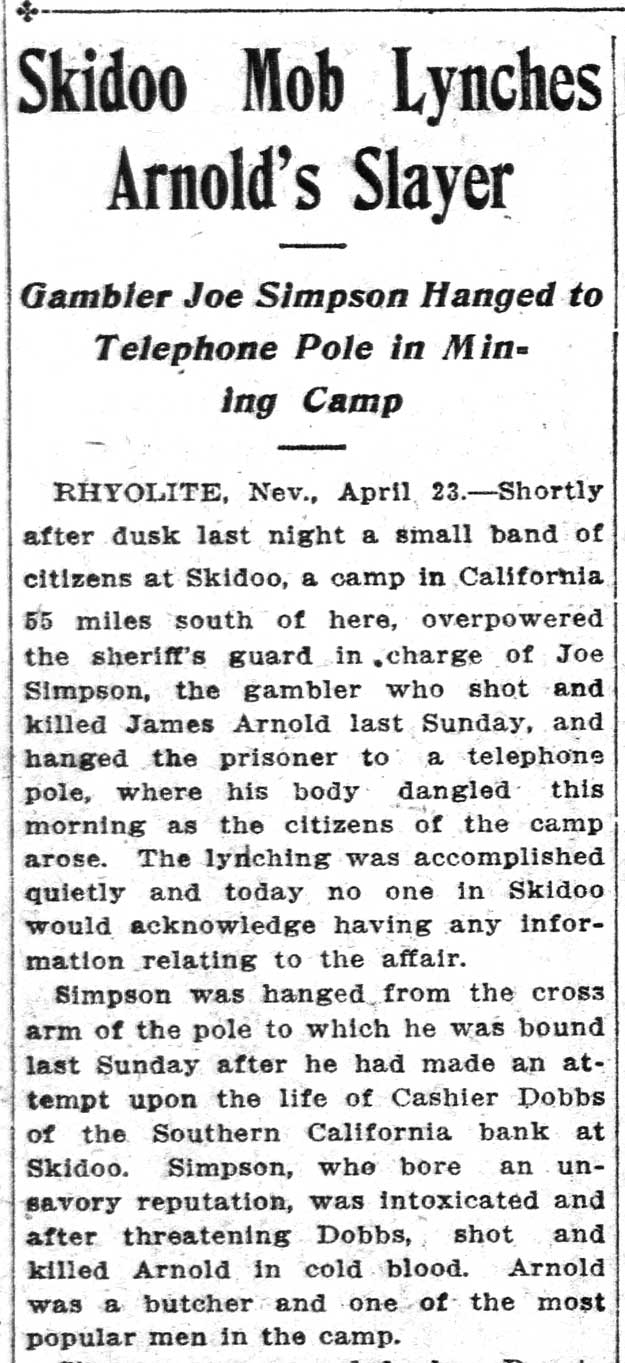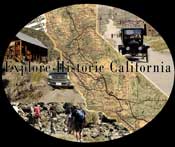Part I of this story ran in our
February, 2014 edition. You can read it
here.
Max, the
second child, of Joseph and Marguerite Skinner was 13 years old
when the family of seven arrived in Lone Pine in 1882 in transit
to Bridgeport via Walker Pass due to snows. “This is where we
are going to stay,” announced Marguerite, and the McCall Ranch
became their home. Joseph relied on his skills as freighter and
Max helped by taking the reins of the ten to sixteen horse teams
they used to deliver charcoal to furnaces of Darwin and Modoc
and various other mining camps.
The trails
were rugged and isolated in harsh desert conditions, but Max
would declare in his senior years that the adventures he and his
father met were “all in a day’s work” and soon forgotten. There
was the August when Max ran out of water while hauling pipe from
Panamint up Sheppard Canyon into Darwin for a nine mile pipe
line. He was due in Darwin in the late afternoon, but didn’t
show up until the next morning, presumably delayed because of
the lack of water. Then there was the winter when deep snows
nearly forced his team off the grade. Icy roads proved to be a
problem another trip, as the wagons were forced crossways of the
canyons twice. Yet another trip out of Keeler, a wall of water
nearly washed Max and Sidewinder “Sidey” McClean” and their
horses away before they could narrowly escape to the side of
the hill.
It was a
colorful time for the mining camps, with Beveridge and Cerro
Gordo going strong. Beveridge stood east of Lone Pine three
miles down the west slope of the White Mountains, Max remembered
seeing as many as 100 mills loaded on pack mules along the
streets of Lone Pine on their way to the rich mines. Remi
Nadeau’s teams could be also be seen coming out of Cerro Gordo,
the richest lead-silver mine in the world, according to Max,
hauling the 200 plus miles to Wilmington to be loaded on the
steamships to the mint in San Francisco.
In 1892, Max
drove twenty mule team Borax freight wagons for John Searles
from the site of Searles (Station) to Mojave. The trip took
eight days, but was the easiest job he ever had. Unlike Nadeau’s
teams, there were no changes of drivers, wagons or mules. A
swamper did travel ahead of the wagon on horseback on his way to
unmanned stations where he would prepare stables and have supper
waiting for Max’s arrival. The Summit Garden station did have a
keeper and was always a welcome site with its orchard and
garden. Searles himself was considered one of the most
interesting people Max had ever met, self educated, and able to
talk intelligently. Max would relay stories of Searles
adventures as a bear hunter, and the time he was mauled, forcing
Searles to wear a plate in his jaw because of injuries.
John Shober
was among the pioneers that Max Skinner made acquaintance with.
Shober came to Owens Valley across the mountains on foot, a
whipsaw on his back. It was said that he made five dollars per
board as soon as the board hit the ground, and was an expert in
his field. Shober also helped the Skinners freight charcoal.
Joseph Skinner and John Shober would collect wood in the nearby
hills and burn it into charcoal then haul to the mines for the
furnaces.
Horace Bellas,
a resident of Haiwee, was remembered by Max for killing Indians
in revenge for Indians killing his brother. Horace was also said
to have pointed his gun with his finger on the trigger then
suddenly realized it was one of his best friends, Allie McGee.
When he saw who it was he exclaimed, “My God, Allie, I pert near
got yuh.” This incident changed Bellas ways, and the next time
he saw a stranger about ready to kill a man for stealing his
burros, Bellas replied, “Brother, them days have passed. We
can’t do it that way any more.”
Max could
spin yarns by the hour. Crime and justice was often the subject.
Let a man in need ask for help and he was given it immediately,
but let him steal and he often paid with his life. Crowen and
Randall stole horses and were later captured and returned to
town strapped on the horses, the men who found them announcing
simply, “We found the horses and two dead outlaws.” Max also
remembered the infamous hanging in Skidoo. Word was sent to the
Sheriff, but as he could not get there immediately, the hanged
man was cut down. As word finally came that the sheriff was on
his way and would arrive shortly, the hanged man was strung up
again. This was the way of frontier justice.
 |
|
Story from
the San Francisco Call newspaper, April 24, 1908
describing the lynching in Skidoo, Calif. Read the
complete story
here.
Library of
Congress, Historic American Newspapers collection |
A man named
Spanish Joe told Max about going to Death Valley. When he got to
the ranch an old woman was sitting in a rocking chair. Joe
noticed no movement for a length of time, and he couldn’t stop
looking at her. “You needn’t be afraid of her. She’s dead,”
someone told him. The poor woman had been lost on the salt
marsh, died, and become mummified. Joe didn’t mention how long
the woman was kept in the rocker on display.
Father John
Crowley, the Desert Padre, knew Max Skinner, and one day in the
1930’s the two began reminiscing about the old days. Randsburg
was a favorite subject, in the days when it was a booming tent
city. Max was given the contract for a row of wooden buildings.
After the buildings were constructed, the paint job was given to
a man named Buster. Another man named Irons was in competition
for the contract and was so angry that he didn’t get it, he
waited for Buster to erect a scaffold. While Buster was perched
on it, Irons kicked out the scaffold supports. Buster, paints
and all fell in the process. As he hit the ground fighting, the
skirmish between the two began and the law was called in.
Randsburg only had a one cell jail. The decision was made that
Buster and Irons would explain to the judge that it was all a
joke, and the possibility of the two men being locked up in one
cell and creating a first class murder was avoided.
Father
Crowley and Max also speculated on the safest place to be during
gun play in Randsburg. Max remembered telling a partner of his
that the least exposed position was to be stretched out on the
ground. Max and partner decided to act on the theory, both
laying down side by side in an unfinished Randsburg store.
Meantime, a quarrelsome gentleman began dissecting another in a
nearby saloon. The bartender reached under the bar and pulled
out a rifle, aimed it at the man, and wound up killing a
slumbering miner across the street as he lay in his blankets on
the floor. The intended victim hid in a piano box, which the
riflemen proceeded to pepper with bullets, causing no damage
except the removal of the occupant's ear.
Father
Crowley, in return, relayed the story of Mrs. Jud Collins of
Bishop, whose mother, Mrs. Woods, lived at Lida during the boom
days of Goldfield. The town was full or prospectors. Mrs. Woods
enlisted a group of the men to move a large stove that was
outside her kitchen. In the process of moving, the door fell
open, and a man was revealed crouched inside. The oven was his
chosen hiding spot to avoid being shot by someone whom he had
offended. Another man in the same town was said to have leaped
into a well as he was being pursued, a low bullet clipping off
the heel of his boot. The results of Father Crowley's and Max
Skinner’s speculations on safe hiding places during gun play
remained unsettled between the two.
These are but
a few of the adventures of Max Skinner and the rough and tumble
times of the old mining camps. Members of the Skinner family
live on to tell these tales and more. Our sources of Max’s tales
come from the following publications:
Bibliography
The Album Times & Tales of Inyo-Mono, Vol. V No.4.
Chalfant Press, Inc.
October, 1992, A Skinner Family Record by Frances
V. McIver & Pat Boyer
Desert Padre: The Life and Writings of Father John J.
Cowley 1891-1940
by
Joan Brooks
Mesquite Press 1997
Saga of Inyo County
Chapter 83 Southern Inyo AARP, 1977
Max Skinner: As Told to Clarice Uhlmyer, by Max, in 1940
